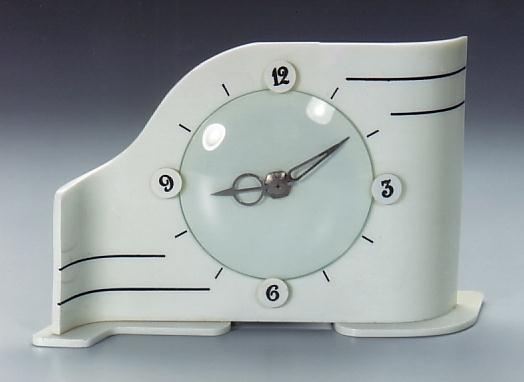| David Wells, vintage pen collector and dealer of primarily
British writing instruments continues his discussion on a delicate material
used by several pen companies in the past. Before the introduction of
colourful resins and celluloid materials, fountain pens were made from
vulcanised rubber with colour variations limited mostly to black , red
or a variation of the two we call mottled, ripples or wood grains. Casein
material was one of the first alternatives to provide a wide variation
of colour and patterns.
Why casein?
Casein has been described as "the most beautiful of plastics"
and was produced in a wide variety of colours including delicate pastel
shades, pearls and mottles, especially those imitating tortoiseshell and
horn. The material also readily takes a surface dye and this process was
extensively used to produce fashionable colours at short notice and for
two colour effects by selectively cutting back the dyed surface layer.
Casein plastics take an attractive polish which can be achieved mechanically
with abrasives (except for surface-dyed material) or chemically by immersion
in hot, hypochlorite solution - known as dip polish.

a casein clock from 1930
The problems with casein
The manufacture of casein is a slow, batch process requiring the material
finally to be hardened by immersion in formaldehyde solution - sections
of about 25mm thickness requiring up to one year. Casein plastics are
not readily moulded, although sheet can be pressed into a limited range
of shapes, such as shallow bowls and candlestick bases, by 'hot stamping'
. Instead, casein objects are fabricated from stock material such as sheet,
rod or tube.

Conway Stewart 475
Casein does not seem to be an ideal material to make fountain pens from,
as it is hydroscopic and expands with the absorption of water. Fortunately
fountain pens sections are never made from Casein so immersion in ink
is not a problem. Using a casein fountain pen in a climate with high humidity
is another story. Walter A. Sheaffer, in his memoirs, recounts how his
firm produced a line of coloured casein pens which proved quite popular
until the weather turned hot, whereupon the casein swelled to the point
that the sections fell out (it is suspected the swelling had less to do
with the heat than with the humidity of a Midwestern summer). The pens
had to be exchanged, and Sheaffer states that they were subsequently recycled
as loaners – presumably for cool weather use!
The last thing you should ever do with a casein fountain pen
is soak it in attempts to remove ink stains or dried ink build-up.
Just a few hours in water will be enough to cause the casein to
expand by about 10% and will result is the material becoming very
soft. If then left to dry out the swelling will shrink but it will
almost certainly lose its shape and will be damaged beyond repair.
It is reputed that if left in water for long enough a casein fountain
pen will disintegrate. I have not yet tried this but the next time
I get a broken casein pen I might just try it.
Limited quantities of casein plastics are still produced in some
countries with large dairy interests, for example New Zealand, and
only a few casein fountain pens are manufactured today.
|
|
|
casein inkwell from
1920's |
How do I know its casein?
Well there are three ways to find out, one destructive and the other non-destructive.
Unfortunately one of the definitive tests is the destructive one! If you
want to be certain that it is casein, the soak test will prove it, shame
that it has just destroyed your pen!
David Nishimura, well known vintage pen collector
and dealer notes :
Destructive testing doesn't mean destroying the entire object.
A tiny scraping may be taken from the inside of the barrel or cap.
Place the scraping on a glass microscope slide, and test it with
solvents. Acetone will dissolve a celluloid scraping. It will not
dissolve casein.
David also notes for technical accuracy "casein" is not capitalized.
It is not a trade name. It is a material, like "wood", "water"
and "milk".
For the more cautious, try the hand and colour test. Is the pen a Conway
Stewart model, highly coloured and has an irregular colourful pattern?
If the answer is yes to all these, it could well be casein. Pick the pen
up and hold it in your hand. Does it feel warm to the touch? Yes, then
the chances are that it is casein. Obviously it may not be highly coloured
or not have an irregular pattern, and it may not be a Conway Stewart,
but these factors don’t exclude it being casein, they just reduce
the chances.
Jonathan Donahaye, prominent Conway Stewart
collector comments :
I have frequently noted vintage casein made pens sometimes have a sort
of crazy-paving or "craquelé" effect over the surface.
This does not seem to occur in other materials and seems to be quite specific
for identifying casein. Probably this occurs when the pen has been left
for years in the light or perhaps in warm situations where it is affected
by frequent moisture changes. This phenomenon is detrimental to the pen
quality because the cracks are deep and no amount of abrasives will get
them out without damaging the pen. Also the brilliant shine of casein
pens is affected by these cracks so that the pattern becomes duller and
less attractive. However, many Conway Stewarts from the 30s show no sign
of this effect. Perhaps they have been stored away for years in drawers
and boxes and so have been spared the ravages of time.
References:
David Wells Vintage Pens
Jonathan
Donahaye Conway Stewart Collection
Conway
Stewart history
Home of the Plastics Historical
Society
Sandretto Plastics Museum
Turin, Italy
|